USE SYNTHETIC SUBSTITUTION TO EVALUATE FOR THE GIVEN VALUE
Use synthetic division to evaluate the function for the indicated value of x.
Problem 1 :
f(x) = -x² - 8x + 30; x = -1
Solution :

From the synthetic division above, we have
f(-1) = 37
Problem 2 :
f(x) = 3x² + 2x – 20; x = 3
Solution :
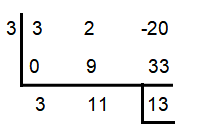
From the synthetic division above, we have
f(3) = 13
Problem 3 :
f(x) = x³ - 2x² + 4x + 3; x = 2
Solution :
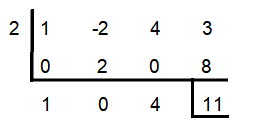
From the synthetic division above, we have
f(2) = 11
Problem 4 :
f(x) = x³ + x² - 3x + 9; x = -4
Solution :
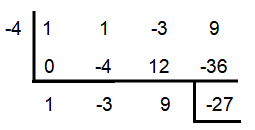
From the synthetic division above, we have
f(-4) = -27
Problem 5 :
f(x) = x³ - 6x + 1; x = 6
Solution :

From the synthetic division above, we have
f(6) = 181
Problem 6 :
f(x) = x³ - 9x – 7; x = 10
Solution :
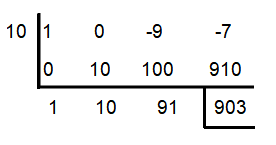
From the synthetic division above, we have
f(10) = 903
Problem 7 :
f(x) = x4 + 6x² - 7x + 1; x = 3
Solution :

From the synthetic division above, we have
f(3) = 115
Problem 8 :
f(x) = -x4 - x³ - 2; x = 5
Solution :
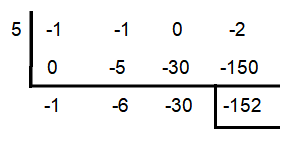
From the synthetic division above, we have
f(5) = -152
Problem 9 :
The profit P (in millions of dollars) for a DVD manufacturer can be modeled by
P = −6x3 + 72x
where x is the number (in millions) of DVDs produced. Use synthetic division to show that the company yields a profit of $96 million when 2 million DVDs are produced. Is there an easier method? Explain.
Solution :
P = −6x3 + 72x
When Number of DVD's produced = 2 million, then profit = 96 million. To prove this, we use the method of synthetic division.

Yes, there is a easier way. Applying x = 2 in the original function, we will get the remainder.
Let P(x) = −6x3 + 72x
When x = 2
P(x) = −6(2)3 + 72(2)
= -6(8) + 144
= -48 + 144
= 96 million
Problem 10 :
You use synthetic division to divide f(x) by (x−a) and find that the remainder equals 15. Your friend concludes that f(15) = a. Is your friend correct? Explain your reasoning.
Solution :
Given that, while dividing the given polynomial f(x) by x - a, we get the remainder 15. Which means applying x = a, we get the remainder 15. Accordingly this understanding f(a) = 15
But your friend concludes that f(15) = a. Then your friend's argument is incorrect.
Problem 11 :
The graph represents the polynomial function f(x) = x3 + 3x2 − x − 3.
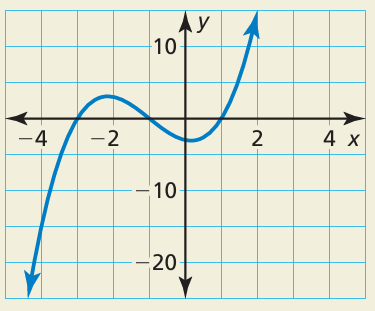
a. The expression f(x) ÷ (x − k) has a remainder of −15. What is the value of k?
b. Use the graph to compare the remainders of (x3 + 3x2 − x − 3) ÷ (x + 3) and (x3 + 3x2 − x − 3) ÷ (x + 1)
Solution :
a) Since the remainder is -15 which dividing the polynomial by the linear factor. By observing the curve, we know that one of the point is (-4, -15). When x = -4, the value of f(-4) is -15. From this, we understand that f(x) ÷ (x + 4), the remainder is -15. So, the value of k is -4.
b)
x + 3 = 0
x = -3
By observing the curve, it passes through the point (-3, 0). So, the remainder is 0 while dividing the polynomial by x + 3.
x + 1 = 0
x = -1
By observing the curve, it passes through the point (-1, 0). So, the remainder is 0 while dividing the polynomial by x + 1.
Problem 12 :
The volume V of the rectangular prism is given by V = 2x3 + 17x2 + 46x + 40. Find an expression for the missing dimension.
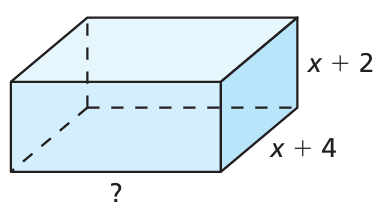
Solution :
V = 2x3 + 17x2 + 46x + 40
Volume of rectangular prism = length ⋅ width ⋅ height
Length = ?, width = x + 4 and height = x + 2
length ⋅ (x + 4) ⋅ (x + 2) = 2x3 + 17x2 + 46x + 40
Length = (2x3 + 17x2 + 46x + 40) / (x + 4)(x + 2)
x + 4 = 0 and x + 2 = 0
x = -4 and x = -2
Using synthetic division, let us divide the polynomial by x + 2.

2x2 + 13x + 20
Now let us divide the polynomial by x + 4.
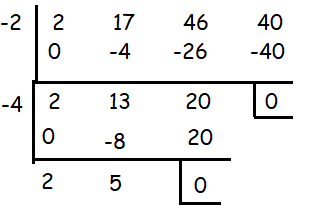
We get the quotient, which is 2x + 5.
So, the missing length of the rectangular prism is 2x + 5.
Problem 13 :
What is the value of k such that
f(x) = (x3 + kx2 - 9x - 36)/(x + 4)
has a remainder of zero? Use the easier way.
Solution :
While dividing the polynomial by x + 4, we get the remainder 0. To do the problem in easiest way, we may apply x = -4 in the given polynomial.
f(x) = (x3 + kx2 - 9x - 36)
x + 4 = 0
x = -4
f(-4) = (-4)3 + k(-4)2 - 9(-4) - 36
0 = -64 + 16k + 36 - 36
0 = -64 + 16k
16k = 64
k = 64/16
k = 4
So, the value of k is 4.
Recent Articles
-
Finding Range of Values Inequality Problems
May 21, 24 08:51 PM
Finding Range of Values Inequality Problems -
Solving Two Step Inequality Word Problems
May 21, 24 08:51 AM
Solving Two Step Inequality Word Problems -
Exponential Function Context and Data Modeling
May 20, 24 10:45 PM
Exponential Function Context and Data Modeling